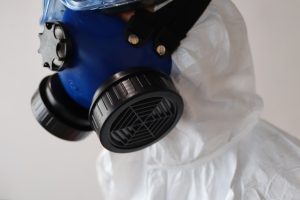This article was provided courtesy of DeSantis Property Management

For landlords, one of the biggest issues in operating a rental is the constant possibility of legal liability from renters bringing lawsuits. As a landlord, you must be fully aware of the different issues that pose a risk to the safety and comfort of your tenants.
One such issue, which has been getting a lot of attention, is the presence of radon in rental properties. Understanding the implications of radon exposure in your property is vital if you want to protect your real estate investments. This article explains everything you need to know.
What is radon?
Radon is a naturally occurring radioactive gas that’s found in several soil types. It is produced by the natural decay of uranium, so it is more prevalent in uranium-rich soils. The gas is usually formed deep inside the ground before it travels slowly toward the surface.
If there is no building over the soil where radon is released, the gas disperses into the atmosphere. When this happens, the concentration of radon is not high enough to cause harm. But it is not the same when a house stands over the soil where radon gas is released.
In that case, the gas collects under the foundation of the building and over time finds its way into the home by seeping through cracks in the foundation. Because the gas collects within the enclosed space of the home it can build up to a toxic level inside the house.
Effects of radon exposure

Because radon is invisible, odorless, and tasteless, it can be present in a home without anyone knowing it. This is part of what makes radon such a threat to humans. Radon is measured in picocuries per liter, or pCi/L and anything above 4pCi/L is considered hazardous to health.
While smoking is the highest cause of cancer among smokers, radon exposure is the leading cause of cancer among non-smokers. 21,000 people die from lung cancer every year in the United States. About 2,900 of those deaths are caused by radon exposure.
What is the risk of radon in your rental property?

Typically, radon exposure is more likely in locations where the soil contains rocks. That is because uranium is present in all rock types, to varying degrees. Also, since the soil is created when rocks are broken down, there is a chance that every soil contains traces of uranium.
What this means is that any home can be exposed to radon to some extent. This is not a question of how old or new a building is, and whether it has a basement or not. As long as there is a possibility that the soil beneath it contains uranium, a rental home can be exposed to radon.
Is a landlord responsible for radon in a rental property?
Landlords are responsible for providing a safe and habitable dwelling for their tenants. This is contained in the implied warranty of habitability; the assurance landlords give to tenants that they have done everything to ensure the livability of a rental.
To meet this responsibility, landlords are expected to address the threat of radon in the rental property, even if this is not a requirement in their state. Because the gas is virtually undetectable, there is no way to do this without actually testing for radon in your rental property.
Moreover, it is vital to do this as soon as possible and act if there is any trace of radon in the property. Why is this so important? Because lung cancer often doesn’t occur until between 5-25 years after the person has been exposed to radon.
This means a landlord can still be liable to lawsuits by tenants years after they have left the home. Furthermore, not knowing about the radon problem does not absolve a landlord of blame, especially if the tenant asked about the issue in the past or the problem is prevalent in the area.
How to address radon issues in a rental

The first step is to test the rental home for radon. You should do this if you have not tested for radon in the last two years or have recently done some remodeling. If the test results show radon levels of 4 picocuries per liter of air (pCI/L) and over, you should take immediate action.
Reducing radon concentration in a home is not something you can do by yourself. The specific steps to solve the problem depend on the recommendations of an expert. To get the best results you should only use a qualified mitigation contractor in your area listed by your state EPA office
If there is no radon in your rental or the concentration level is negligible, you can prevent radon by taking the following steps:
- Install a layer of gas-permeable aggregate under the slab or the flooring of the rental
- Install a gas-tight pipe from this layer or crawlspace to the roof
- Install a fan in the attic to vent gases out of the home
- Seal cracks in the foundation and walls by caulking them
